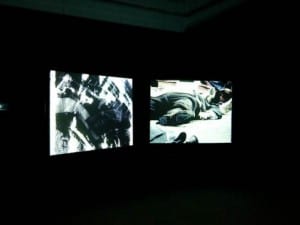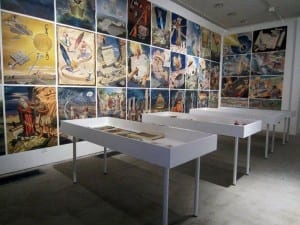Peintures Carrées (Square Paintings) is a new exhibition of works on square, screen-reprinted Plexiglas by French artist Jean-Marc Bustamante (b. 1952). Bustamante is a noted conceptual and installation artist who incorporates ornamental design and architectural space into his work. Emerging principally as a photographer in the 1970s, Bustamante has since explored the space between photography, sculpture, architecture and decor. His work represents mental landscapes and combines different artistic languages where past experiences blend to create a unique visual experience.
This new series of work, titled Colorito Colorado, makes reference to the Renaissance era when the key characteristic of the Venetian school was colour rather than drawing, with form achieved by painting in layers. Indeed, the initial impact is all about colour and the colours are dazzling. The shapes are reminiscent of simple, computer scribbles that could be construed as flattened sculptures. The process begins with Bustamante expansively drawing or applying large strokes of colour with felt pen on graph paper. Any trace of human interaction in the form of brush strokes or the layering of paint is removed through computer processing, and the image is then transformed on Plexiglas by the traditional process of silk screening. The Plexiglas plate is held in place by steel studs and defined by a steel frame.
In this context, and in the use of industrial processes, it is not surprising that some critics have made reference to Warhol in terms of simplicity and ethic, although Bustamante’s work suggests that there are secrets to be uncovered and a greater level of detail beneath the somewhat flat, simplistic exterior. Bustamante likes to intrigue the viewer and this ambiguity leaves much of his work open to interpretation.
These works significantly develop his exploratory techniques using light and colour. Cardinal (2010) shows a falling range of colours set against a background of simple grey lines which serve to cast a shadow upon the gallery wall, symbolising motion versus stasis. This ambiguous relationship with form brings a sense of detachment for the viewer which can also be seen in Spring (2011). Using the same combination of colours, this relies less on motion and more on the stability of the senses.
Throughout, Bustamante’s work is both playful and refined. Radiant (2010), possesses flashes of colour upon water whilst Mercator (2010) is the most direct work here, hinting at the artist’s background in photography as well as giving a static chaos that explores the philosophical boundaries between painting and photography. Symbolically, the simplicity represents Bustamante’s rejection of the poetic snapshot that is synonymous with French creative photography.
Bustamante’s unique visual sense of the world lies between space and the context of place as well as the relationship between industry and technology. Ultimately, light and colour have replaced mass and gravity at the heart of his work, creating a renewed sense of timelessness. These works consistently attempt a new and thoroughly modern kind of painting and successfully offer an alternative way of looking at pictures for a brighter, simpler future that has been shaped by the past.
Jean-Marc Bustamante, Peintures Carrées (Square Paintings), 10/01/2012 – 25/02/2012, Galerie Thaddaeus Ropac Debelleyme, 7 Rue Debelleyme, 75003, Paris. www.ropac.net
Aesthetica in Print
If you only read Aesthetica online, you’re missing out. The February/March issue of Aesthetica is out now and offers a diverse range of features from an examination of the diversity and complexity of art produced during the tumultuous decade of the 1980s in Art, Love & Politics in the 1980s, opening 11 February at MCA Chiacgo, a photographic presentation of the Irish Museum of Modern Art‘s latest opening, Conversations: Photography from the Bank of America Collection. Plus, we recount the story of British design in relation to a comprehensive exhibition opening this spring at the V&A.
If you would like to buy this issue, you can search for your nearest stockist here. Better yet call +44 (0) 1904 629 137 or visit the website to subscribe to Aesthetica for a year and save 20% on the printed magazine.





